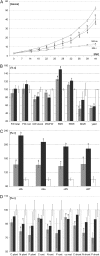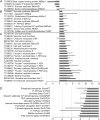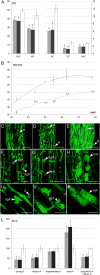Knockdown of the symbiotic sucrose synthase MtSucS1 affects arbuscule maturation and maintenance in mycorrhizal roots of Medicago truncatula
- PMID: 20007443
- PMCID: PMC2815868
- DOI: 10.1104/pp.109.149898
Knockdown of the symbiotic sucrose synthase MtSucS1 affects arbuscule maturation and maintenance in mycorrhizal roots of Medicago truncatula
Abstract
The relevance of the symbiosis-induced Medicago truncatula sucrose synthase gene MtSucS1 for an efficient arbuscular mycorrhiza (AM) was studied using two independent antisense lines that displayed up to 10-fold reduced SucS1 levels in roots. Mycorrhizal MtSucS1-reduced lines exhibited an overall stunted aboveground growth under inorganic phosphorus limitation. Apart from a reduced plant height, shoot weight, and leaf development, a delayed flowering, resulting in a lower seed yield, was observed. In addition, the root-to-shoot and root weight ratios increased significantly. Gene expression studies demonstrated a major reversion of AM-associated transcription, exhibiting a significant repression of well-known plant AM marker and mycosymbiont genes, together indicating a diminished AM fungus colonization of MtSucS1-antisense lines. Concomitantly, gas chromatography-mass spectrometry-based metabolite profiling revealed that mycorrhizal MtSucS1-reduced lines were affected in important nodes of the carbon, nitrogen, and phosphorus metabolism, accentuating a physiological significance of MtSucS1 for AM. In fact, antisensing MtSucS1 provoked an impaired fungal colonization within the less abundant infected regions, evident from strongly reduced frequencies of internal hyphae, vesicles, and arbuscules. Moreover, arbuscules were early senescing, accompanied with a reduced development of mature arbuscules. This defective mycorrhiza status correlated with reduced phosphorus and nitrogen levels and was proportional to the extent of MtSucS1 knockdown. Together, our results point to an important role for MtSucS1 in the establishment and maintenance of arbuscules in the AM symbiosis.
Figures




References
-
- Alexander T, Toth R, Meier R, Weber H (1989) Dynamics of arbuscule development and degeneration in onion, bean, and tomato with reference to vesicular-arbuscular mycorrhizae in grasses. Can J Bot 67 2505–2513
-
- Balestrini R, Bonfante P (2005) The interface compartment in arbuscular mycorrhizae: a special type of plant cell wall? Plant Biosyst 139 8–15
Publication types
MeSH terms
Substances
LinkOut - more resources
Full Text Sources
Other Literature Sources

